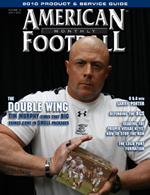Article CategoriesAFM Magazine
|
Reading the Proper Visual Keys - A True Essential In Stopping the Runby: Brad ForsheyDefensive Line Coach and Director of Football Operations, West Liberty University © More from this issue Effective defensive line play in football involves much more than three or four guys butting heads with the offensive line. Numerous physical techniques – hand placement, stance, shedding blockers, etc. – have been developed and refined in an attempt to overcome the offense’s built-in advantage of knowing where the play is going. All too often, an equally important mental technique which directly addresses this issue is overlooked. At West Liberty University, we devote significant time and effort to teaching our players how to read and respond to visual keys quickly and effectively.
|
|
|||||||
| HOME |
MAGAZINE |
SUBSCRIBE | ONLINE COLUMNISTS | COACHING VIDEOS |
Copyright 2025, AmericanFootballMonthly.com
All Rights Reserved





